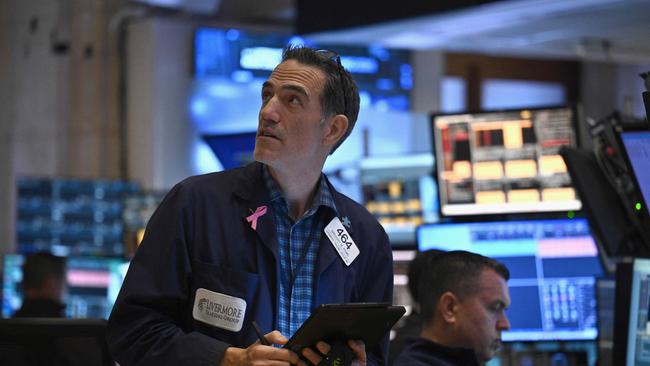Dovish message from Jerome Powell at Federal Reserve may fuel ‘melt up’ in stocks
Jerome Powell’s language at the closely watched Economic Policy Symposium was a touch stronger than expected. If markets start to sell off now they might be fighting the Fed.

Stocks have already had a very strong rebound and Jerome Powell’s dovish message at Jackson Hole was consistent with expectations, but investors may not want to “fight the Fed”.
Apart from a higher Japanese yen and lower US Treasury yields, markets are essentially back to where they were at the end of July. The S&P 500 bounced about 10 per cent and the ASX 200 bounced 6 per cent in under three weeks. Both were closing in on record highs.
The rebound came as US economic data didn’t confirm recession signals in ISM Manufacturing and Non-Farm Payrolls data and the Bank of Japan “blinked” on further rate hikes, at least verbally.
The other factor was of course the expectation that the Fed was ready to start cutting rates and that Fed chair Powell would leave his options open on the “timing and pace”, which was confirmed on Friday.
However, Powell’s language at the closely watched Economic Policy Symposium was a touch stronger than expected. If markets start to sell off now they might be fighting the Fed.
“Powell certainly went hard at Jackson Hole,” Chris Weston, Pepperstone head of research, said.
“He sounded a tad concerned that policy was behind the curve, but the sounds of back slapping and high fives that the Fed had beaten inflation were loud and clear.”
The reward for risk may not be compelling at these levels, but after Powell’s speech, a renewed downturn seems less likely until after a “melt-up” in the S&P 500 to fresh record highs.

A fall in sharemarket volatility back to the extremely low levels hit last month would make a decision to sell stocks easier. Middle East developments this week and Nvidia’s quarterly results and outlook on Thursday morning Australian time are potential swing factors.
Stocks would probably be vulnerable to weaker than expected US economic data, particularly on the labour market, with the non-farm payrolls report on September 6 more important than ever.
US political uncertainty is also a potential cause of anxiety for investors, as while election years are normally positive, the current presidential race is very much like a coin flip between two candidates with very different views on economic policy including taxes, trade and regulation.
“Stockmarkets generally don’t like navigating political volatility, and I think weighing various outcomes will be a particularly difficult task in this instance,” said Goldman Sachs global head of hedge fund coverage, Tony Pasquariello. “No one is running on austerity so, with regard to our ever growing deficit, keep an eye on the back end of the bond market.”
He also cautioned about the yen carry trade that roiled markets early this month.
But US share buybacks are currently “the most powerful technical within US equities” and “should be with us to mid-September”, Mr Pasquariello added.
However, one wonders why Powell went as quite as “hard” in a dovish way as he did.
Perhaps it was all about the balance of “risks” from here, rather than what he’s seeing now.
He said upside risks to inflation have “diminished”, downside risks to employment have “increased”.

As highlighted in its July statement, the Federal Open Market Committee is now “attentive to the risks to both sides of our dual mandate”. Powell was able to definitely say that: “The time has come for policy to adjust. The direction of travel is clear, and the timing and pace of rate cuts will depend on incoming data, the evolving outlook, and the balance of risks.”
However, that was really all he needed to say in terms of the policy outlook – unless of course he’s worried about a looming recession that might have already started.
What followed was quite a dovish message that could have been saved for a proper downturn.
“We will do everything we can to support a strong labour market as we make further progress toward price stability,” Powell said. Such an open-ended message of support was fairly strong although partly caveated on an assumption on inflation coming down further.
Powell’s optimism that the “economy will get back to 2 per cent inflation while maintaining a strong labour market” is fair enough given the policy lags. However, that was with “an appropriate dialling back of policy restraint” rather than doing “everything we can to support a strong labour market”.
One approach sounds measured, the other sounds more like a case of doing “whatever it takes”.
Then there was the potentially unnecessary statement of the obvious amount of firepower the Fed has right now with its Fed funds rate at a 24-year high of 5.37 percentage points.
“The current level of our policy rate gives us ample room to respond to any risks we may face, including the risk of unwelcome further weakening in labour market conditions,” Powell said.
While the consensus among FOMC members is that the long-term neutral Fed funds rate is around 2.75 per cent, Powell’s unquantified “ample room to respond” comment will leave some investors thinking he’s prepared to cut the Fed funds rate all the way to zero again if things turn ugly.
Powell’s reference to “any risks” might include market dislocations.
That kind of catch-all statement might lead would-be sellers to hold their fire.






To join the conversation, please log in. Don't have an account? Register
Join the conversation, you are commenting as Logout